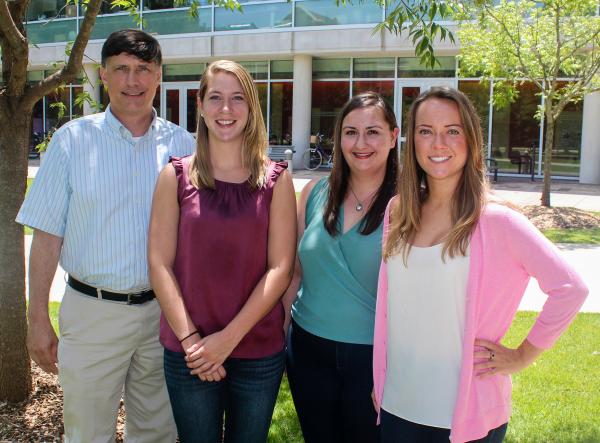Study Abroad course explores the engineering thought process.
You know this one: “The optimist sees the glass as half-full and the pessimist sees the glass as half-empty, but the engineer sees a glass that’s twice as big as it needs to be.” It’s an old joke that demonstrates, anecdotally, how engineers think, which is something that Joe LeDoux, an associate professor in the Wallace H. Coulter Department of Biomedical Engineering (BME), has been very interested in.
But, rather than ruin an old joke by explaining the punch line, LeDoux took a more empirical approach to understanding the engineering mind. He designed and taught a course on the subject, then wrote about it. And last month, LeDoux and a group of Georgia Institute of Technology students presented a paper to the American Society for Engineering Education (ASEE) that asks, what is it that makes someone an engineer, and what distinguishes engineers from other professionals?
The paper, written by LeDoux, BME research scientist Alisha Waller, and a trio of undergraduates who actually took the class – Jacquelyn Borinski, Kimberly Height and Elaine McCormick – shares the co-authors’ experience in the course, called “Habits of the Engineering Mind,” taught last year by LeDoux at Oxford University as part of Georgia Tech’s study abroad program.
“Taken with a sense of adventure, I decided to teach a course on a topic that I had been thinking about for some time,” LeDoux writes in the paper, presented last month in Indianapolis at the ASEE Annual Conference and Exposition. “The idea was to explore the possibility that engineers have a characteristic way of thinking.”
But there was no textbook, no syllabus, and LeDoux had to basically develop the course from scratch, without the aid of pre-existing conceptions (except, perhaps for a few old jokes about engineers) or guidelines for how to teach it. “As a result, I was a true ‘co-learner’ with my students,” he says. “It was such a powerful and rewarding experience that three of my students and I decided to write a paper about it, to share our experiences with the broader academic engineering community.”
So he developed a set of five long-term learning objectives to help guide the way. A year or more after having taken the course, students will (1) have an understanding of the fundamental ways of engineering thinking, as evidenced by their ability to estimate unknown quantities, represent complex problems diagrammatically, engage in model-based reasoning, and employ multiple engineering habits of the mind as a set of lenses through which to view and think about real-world problems and systems; (2) be able to critically read, analyze, and discuss what philosophers of engineering have written about engineering ways of thinking, and be able to formulate and defend their own arguments about what they think are engineering ways of thinking; (3) see the value of, and be adept at, seeing opportunities for employing engineering habits of the mind as thinking tools in every day, non-engineering contexts; (4) have established a connection between the engineering habits of the mind that were identified and explored in class to their own personal interests and experiences; and (5) recognize that a person’s ways of thinking are influenced by their profession, culture, upbringing, and context, and that a much richer understanding of a problem or system is developed by employing multiple ways of thinking.
The course was dense with reading material, and writing assignments, and discussions, and much of the content was philosophical, rather than technical in nature, so this was definitely outside the norm for a traditional engineering professor and his students. Nonetheless, LeDoux reflects, “the course exceeded my expectations,” and he wonders if success in the Study Abroad program means the course could become a permanent offering on the Georgia Tech campus.
According to LeDoux, the students “learned a great deal about what it means to be an engineer by reading and reflecting on philosophical writings about engineering, and by learning and applying engineering ways of thinking to make meaning of systems that they encounter in their everyday lives. I believe these students are now more aware of their own thinking processes and those of other engineers, and are more sensitive to how these thinking processes affect the work they do and the designs they create, which will, in the end, make them more effective engineers and problem solvers.”
Media Contact
Jerry Grillo
Communications Officer II
Parker H. Petit Institute for
Bioengineering & Bioscience
Keywords
Latest BME News
Jo honored for his impact on science and mentorship
The department rises to the top in biomedical engineering programs for undergraduate education.
Commercialization program in Coulter BME announces project teams who will receive support to get their research to market.
Courses in the Wallace H. Coulter Department of Biomedical Engineering are being reformatted to incorporate AI and machine learning so students are prepared for a data-driven biotech sector.
Influenced by her mother's journey in engineering, Sriya Surapaneni hopes to inspire other young women in the field.
Coulter BME Professor Earns Tenure, Eyes Future of Innovation in Health and Medicine
The grant will fund the development of cutting-edge technology that could detect colorectal cancer through a simple breath test
The surgical support device landed Coulter BME its 4th consecutive win for the College of Engineering competition.








